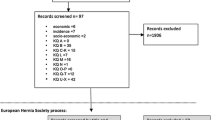Summary
A new bilayer device was used in 759 patients to repair inguinal hernias at the Hernia Institute of Florida. All but three procedures were done under local or regional anesthesia, and all patients were ambulatory. Results are encouraging, though the time these patients have been followed is short. There has not been a failure noted or reported. Minor postoperative complications, consistent with rates of other open hernia repair procedures, have occurred. The unique feature of this polypropylene mesh device is that it has three attached components. Its underlay patch provides a posterior mesh repair. Its connector has the desirable attributes of a plug repair. Its onlay patch covers the posterior wall, well lateral to the internal inguinal ring. A few sutures in the onlay patch assure the stability of the entire three-part, one-piece device. A description of the myopectineal orifice and commentary of its significance is presented. One purpose of publishing this early report is to share with other surgeons some personal observations that can help to simplify technique of dissection of the posterior space, and the deployment of the underlay patch.
Similar content being viewed by others
References
Arregui ME (1995) A laparoscopic perspective of the anatomy of the peritoneum, preperitoneal fascias, transversalis and structures in the space of Bogros. Postgraduate General Surgery 6: 30–36
Condon RE (1978) Hernia. Second edition,
Nyhus Ebert P (1990) Bulletin of the American College of Surgeons: May issue, editorial
Gilbert AI (1989) An anatomic and functional classification for the diagnosis and treatment of inguinal hernia. Am J Surg 157: 331–333
Gilbert AI (1997) Symposium on the management of inguinal hernias. Sutureless technique: second version. Canadian Journal Surgery 40: 209–212
Lichtenstein IL (1989) The tension-free hernio-plasty. Am J Surg 157: 188–193
Read RC (1994) Transversalis fascia-a reanalysis. In: Inguinal Hernia: advances or controversies? Arregui ME, Nagen RF, Radcliffe Medical Press, Oxford and New York: 35–39
Rives J (1968) Les pièces en Dacron et leur place dans la chirurgie des hernies de l'aine. A propos de 65 cas recueillis dans une statistique intégrale de 274 interventions pour hernie. Ann Chir 22: 159–171
Robbins AW, Rutkow IM (1993) The mesh-plug hernioplasty. Surg Clin North Am 73: 501–512
Shulman AG, Amid PK, Lichtenstein IL (1992) The safety of mesh repair for primary inguinal hernias. Am Surg 58: 255–257
Wantz GE, (1992) Giant prosthetic reinforcement of the visceral sac for repair of a re-recurrent inguinal hernia. Postgraduate General Surgery 4: 109–113
Author information
Authors and Affiliations
Rights and permissions
About this article
Cite this article
Gilbert, A.I., Graham, M.F. & Voigt, W.J. A bilayer patch device for inguinal hernia repair. Hernia 3, 161–166 (1999). https://doi.org/10.1007/BF01195319
Received:
Accepted:
Issue Date:
DOI: https://doi.org/10.1007/BF01195319




